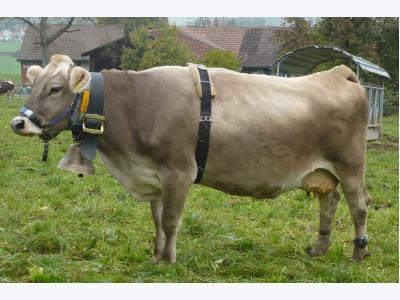Cow bells and their effect on cow behaviour

In alpine regions cows are often equipped with bells. But how do cows experience wearing these bells? Swiss researchers delved into this issue.
An experimental cow wearing a bell and measuring equipment: A thorax belt for measuring heart rate variability, a halter for recording feeding, ruminating, and head movements, and a 3D accelerometer at the hind leg for recording activity and lying.
In alpine regions cows are often equipped with a bell throughout the summer season, i.e. for several months, to ensure that farmers can locate their animals on the wide alpine pastures, many areas of which are obstructed from the view. Various types of bells are available, ranging from small ones for goats and calves to large and heavy ones that are used for traditional purposes like seasonal cattle drives ('Alpabzug') or exhibitions.
To investigate the effect of these bells, a research team, led by Julia Johns from the Institute of Agricultural Sciences from ETH Zürich in Switzerland looked the impact of wearing a bell on behaviour and heart rate variability in dairy cows . The study has been published in 2015.
For the study, 19 non-lactating Brown-Swiss cows with bell experience were assigned to 3 different treatments. For 3 days each, cows were equipped with no bell (control), with a bell with inactivated clapper (silent bell) or with a functional bell (functional bell). The bells weighed 5.5 kg and had frequencies between 532 Hz and 2.8 kHz and amplitudes between 90 and 113 dB at a distance of 20 cm. Data was collected on either the first and third or on all 3 days of each treatment.
Whereas duration of rumination was reduced with a functional bell and a silent bell compared with no bell, feeding duration was reduced with a silent bell and was intermediate with a functional bell. Head movements were reduced when wearing a silent bell compared with no bell and tended to be reduced when wearing a functional compared to no bell. With a functional bell, lying duration was reduced by almost 4 hours on the third day of treatment compared with the first day with a functional bell and compared with no bell or a silent bell.
All additional behavioural measures are consistent with the hypothesis of a restriction in the behaviour of the cows wearing bells, although this pattern did not reach significance. There was no treatment effect on heart rate variability, suggesting that the bells did not affect vago-sympathetic balance. An effect of experimental day was found for only 1 out of 10 behavioural parameters, as shown by a decrease in lying with a functional bell on day 3.
The results indicate behavioural changes in the cows wearing a bell over 3 days, without indication of habituation to the bell. Altogether, the behavioural changes suggest that the behaviour of the cows was disturbed by wearing a bell. If long-lasting, these effects may have implications for animal welfare.
Related news
 Diseases of Cattle: Leptospirosis
Diseases of Cattle: Leptospirosis At least five species of leptospira, a corkscrew-like bacteria, affect cattle in the United States. The most common species affecting cattle is L. pomona.
 Diseases of Cattle: Listeriosis
Diseases of Cattle: Listeriosis Listeriosis, a disease of the central nervous system, is caused by the bacterium Listeria moncytogenes. This bacterium can live almost anywhere--in soil
 Diseases of Cattle: Lumpy Jaw
Diseases of Cattle: Lumpy Jaw Actinomycosis or lumpy jaw produces immovable hard swellings on the upper and lower jawbones of cattle, commonly at the central molar level.